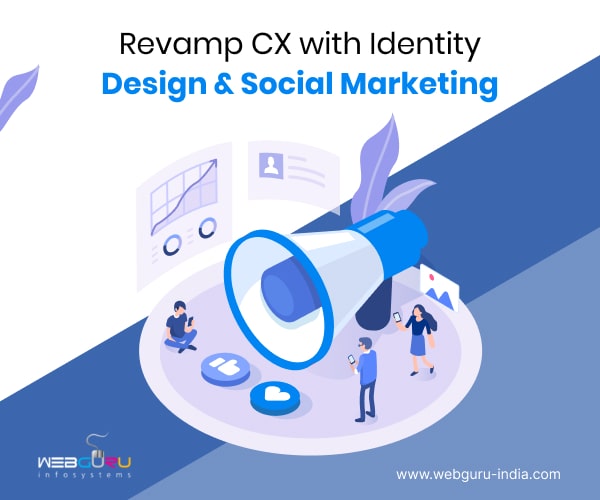Home Blog Digital Marketing Services How a Great Customer Experience Can Grow Your Bottom Line (Retention, Satisfaction, and Revenue)
How a Great Customer Experience Can Grow Your Bottom Line (Retention, Satisfaction, and Revenue)
- 06 May / 2024
- 845 views
- 7 Min Read

In today’s fiercely competitive marketplace, integrating a stellar customer experience (CX) into your corporate identity design is crucial for business success. This blog will explore how enhancing CX significantly boosts customer retention, satisfaction, and ultimately revenue growth. We will also highlight the role of social media marketing as an integral component of modern CX strategies.
Social marketing encourages quick engagement with new products, with 64% of satisfied customers willing to try new offerings immediately. By weaving these strategies into your corporate identity, you can transform client perceptions and strengthen your brand’s market presence.
A staggering 95% of consumers are likely to recommend a company if they rate its CX as “very good.” Moreover, 94% of these consumers are very likely to repurchase, reinforcing the notion that exceptional CX is not merely advantageous but essential for driving business success.
The Foundation of Customer Experience
A great customer experience (CX) adapts to different business contexts, always prioritizing the buyer’s needs and satisfaction. As we’ve transitioned into the digital age, client expectations have evolved dramatically. Consumers now demand instant responses and personalized interactions across all digital platforms. Recognizing these changes is essential for businesses aiming to stay competitive.
Adopting a client-centric approach in every aspect of business operations is critical. This strategy guarantees constant alignment of decisions and processes with the goal of enhancing customer satisfaction. In the end, putting the customer at the heart of your business has two benefits. It meets their changing expectations and drives your company’s growth in terms of buyer retention, satisfaction, and revenue.
Customer Retention Through Experience
A positive customer experience significantly boosts retention rates. Effective communication and active engagement are key strategies for sustaining long-term client relationships. Integrating social media marketing services enhances these interactions, providing platforms for continuous dialogue and feedback.
Additionally, consumer loyalty programs and personalized experiences play pivotal roles in retaining customers. These programs reward repeat business, while personalization makes customers feel valued and understood. By focusing on these elements, businesses can ensure buyers remain satisfied and loyal.
This approach not only maintains a stable customer base but also transforms occasional shoppers into dedicated advocates, driving sustained revenue growth.
Driving Customer Satisfaction to New Heights
Customer satisfaction hinges on several key factors: service quality, product reliability, and emotional engagement. Companies like Apple and Amazon excel in these areas, consistently topping client satisfaction charts. From them, we can learn the importance of reliable products and empathetic service.
These companies also excel at creating emotional connections with their buyers, making each interaction feel personal and valued. This approach not only satisfies customers but also spurs positive word-of-mouth marketing. Happy consumers naturally share their positive experiences, extending the company’s reach and attracting new customers.
By understanding and replicating these practices, businesses can elevate their buyer satisfaction and enjoy the ripple effects of enhanced reputation and increased customer loyalty.
Revenue Growth Fueled by Stellar Customer Experience
Stellar customer experience directly boosts revenue growth, as proven by numerous case studies and industry data. For example, companies with great client service often have more sales. They do this with successful upselling and cross-selling. These strategies work best when businesses deeply understand their buyers’ needs and satisfaction levels.
Improving the consumer experience significantly enhances the customer’s lifetime value, a crucial metric for long-term profitability. Businesses do this by making sure every touchpoint reflects the good parts of the corporate identity design. This creates a consistent, satisfying experience. It encourages customers to return and spend more. This focused approach not only secures ongoing revenue but also solidifies the brand’s reputation in the market.
Social Media Marketing’s Effect on the Customer Experience
Social media is a dynamic tool that significantly enhances the buyer’s experience. Platforms like Facebook and Twitter allow for real-time engagement and support. These are crucial for fast client satisfaction and retention. Instant communication helps businesses. It lets them rapidly address consumer concerns. This turns potential unhappiness into good experiences.
Through comments, direct messages, and reviews, companies can collect insights from their audience. This enables fast adjustments to services or products. This approach resolves issues quickly. It also shows a company’s commitment to its customers. It builds stronger relationships and loyalty.
Leveraging Social Media for Proactive Customer service
Social media serves as a powerful proactive consumer service tool, offering immediate benefits in terms of customer engagement and satisfaction. For instance, companies like Zappos and JetBlue have harnessed social media marketing services to deliver exceptional service, which in turn has boosted their revenue. These brands actively listen to and respond to customer inquiries on platforms like Twitter and Instagram, often before the client escalates issues.
Best practices for adding social media to customer service include training teams to answer questions quickly. They should use social listening tools to track buyer feelings. Also, consumer service representatives should quickly respond to all feedback. Businesses can use these strategies to transform their client service from reactive to proactive. This will improve customer satisfaction and foster loyalty.
Measuring the Success of Your Customer Experience Strategy
There is no other way to understand how the deployment has boosted retention, happiness, and revenue. Metrics that measure gains in the customer experience are essential. Majoritarian indicators give us detail on the buyer journey across many channels, including social media. They include the Net Promoter Score (NPS), the Customer Satisfaction Score (CSAT), and the Customer Effort Score (CES).
Technologies like Google Analytics and social media analytics platforms let us monitor data on prospects and interactions. They help us understand how to keep a consumer entertained. Businesses must adopt an agile strategy. It involves adjusting tactics in response to underperformance or reinforcing successful approaches, given the availability of data around the clock.
Regularly check the consumer experience plan using measurable results and input from the clientele. This will help the business stay up-to-date on consumer concerns. It will let them adapt to evolving needs and foster long-term success and buyer loyalty. You can check out our social media marketing services, which can significantly improve your brand’s exposure.
Conclusion
Giving great buyer service is not just good; it is necessary for thriving in today’s competitive business world. The strategies aim to boost client satisfaction, retention, and revenue. They do this by using social media to engage customers and tracking tools to improve their response.
These strategies ensure that businesses meet and exceed customer expectations. They foster loyalty and drive long-term profitability. We encourage you to assess your current consumer experience strategies. Consider how adding these methods can improve your business. Start today by reevaluating your buyer interactions and setting new benchmarks for success. Take action by calling us now to transform your customer experience and watch your bottom line grow.

Saurav Majumdar
Saurav Majumdar is a curious mind with a never-ending quest for knowledge.

-
1000+
Happy
Clients -
25+
Countries
Served -
19+
Years of
Trust







